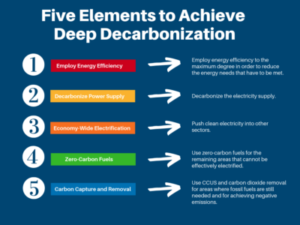This week, the Aspen Institute released its Summary Report of their 2019 Winter Energy Roundtable: Decarbonizing the Electricity Sector & Beyond. Roger Ballentine, co-author of the report along with Jim Connaughton and Dave Grossman, has been co-chair of the Aspen Institute’s Clean Energy Forum for seven years.
Aspen Institute Report Contents
The latest Intergovernmental Panel on Climate Change (IPCC) report has intensified the focus on measures to achieve deep decarbonization. For the United States, most experts say that, if the aim is to be on a 1.5°C pathway, the United States must transition to a net-zero carbon profile economy-wide by around mid-century, going negative thereafter.
At the 2019 Aspen Institute Winter Energy Roundtable, February 25-28, ~50 executives, entrepreneurs, policy makers and thought leaders gathered to tackle how the US can achieve economy-wide decarbonization on a scientifically called-for timeline while ensuring national economic competitiveness and a just transition.
 During these discussions, the group agreed that there are five basic elements necessary to decarbonize the energy system: (1) employ energy efficiency to the maximum degree; (2) decarbonize the electricity supply; (3) electrify other sectors as much as possible, including heat, transportation, and industrial processes; (4) use zero-carbon fuels for the areas that cannot be effectively electrified; and (5) use carbon capture, utilization, and storage (CCUS) and carbon dioxide removal (CDR) for areas where fossil fuels are still needed and for achieving negative emissions.
During these discussions, the group agreed that there are five basic elements necessary to decarbonize the energy system: (1) employ energy efficiency to the maximum degree; (2) decarbonize the electricity supply; (3) electrify other sectors as much as possible, including heat, transportation, and industrial processes; (4) use zero-carbon fuels for the areas that cannot be effectively electrified; and (5) use carbon capture, utilization, and storage (CCUS) and carbon dioxide removal (CDR) for areas where fossil fuels are still needed and for achieving negative emissions.
Read the report to learn more about these five elements or contact us directly.




